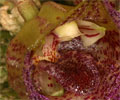|
|
|
|
|
| |
Flasks of
Masdevallia angulata 'MC4522' × self |
|
| |
|
|
| |
| Number: |
TN6498 |
| Name: |
Masdevallia angulata 'MC4522' × self
|
| Type: |
self (What's that?) |
|
Seed Donor: |
Troy C. Meyers
|
|
Click to Enlarge

Pod Parent Flowers |
Click to Enlarge

Pod Parent Closeup of Flower |
|
|
|
| |
Comments: Parent plant: One of the offspring from our TN2740 effort of 2001.
For additional origin/habitat information supplied courtesy of
Charles and Margaret Baker, see further below, near the bottom of this page.
|
Temperatures we attempt to use in the lab & greenhouse:
| For Species: |
|
Spring, Summer, Autumn, Winter: days average 79°F, nights 55°F; best fit is Cool-Intermediate 75-58°F
(Source:
Baker's Web OSC) |
|
About the name...
| Etymology of |
angulata |
|
From Latin "angulatus" with angles, sharp corners.
(Source:
Mayr & Schmucker 1998) |
| Etymology of |
Masdevallia |
|
Named for José Masdeval, physician in the court of Spain.
(Source:
Pridgeon 1992) |
| Pronunciation of |
Masdevallia |
|
maz-de-VAH-lee-ah
(Source:
Hawkes 1978) |
|
If you would like to direct someone to this web page, please copy and paste this URL into your email:
http://troymeyers.com/d?016498
| Flask Information |
| Availability: |
We have sold all of the flasks for this item. |
| You should: |
Consider getting individual plants or compots instead of a flask.
You can place a "Notify Flask Recipients" Request, and either we or a flask recipient may contact you when plants are available.
You may also place a "Notify Retries" Request, and if an identical pollination (the same parents) is done again, we'll let you know.
You may reserve a flask, but it's very unlikely you'll get one ...this could only happen if we found a flask that we didn't know we had. |
| Yield Estimate: |
130 plants (based on flask surveys done 04/28/2010 through 05/26/2011)
|
| Plantlet Sizes: |
From many flasks 20 - 50 mm plants (based on flask surveys done 07/06/2011 through 05/29/2012)
From one most recently surveyed flask 20 - 50 mm (05/29/2012)
|
|
You might also want to:
|
View the seed assay for this item.
View items of the same species.
View items of the same genus.
|
| Ordering Information |
| You are not currently logged in. |
|
You must be a registered user and be logged in to reserve a flask or place a notification request. Please log in:
|
|
|
|
|
|
| |
The origin/habitat information below is supplied courtesy of Charles and Margaret Baker
The following information is based on the name of the plant provided by the donor, and assumes that the name is correct. If the plant has been misidentified, then the following information may not be correct.
This text is copyrighted by the Bakers and may not be reproduced without permission.
ORIGIN/HABITAT: Colombia and Ecuador. This species is relatively common
and locally abundant in the cloudforests of Pichincha, Imbabura and Manabí
Provinces of northwestern Ecuador. In addition, plants have recently been
discovered in neighboring southern Colombia above Ricaurte in the
Department of Nariño. Plants are usually found at 4900-6900 ft. (1500-2100
m), but in Manabí Province in Ecuador, they have been reported growing as
low as 1950 ft. (600 m). Plants seem to grow equally well as epiphytes on
mossy trees in cloudforests or as terrestrials in shady humus or on dirt
road embankments. They may also occasionally be found growing on rocks.
More about this information and the Bakers...
|
|
|
| |
|
|
|